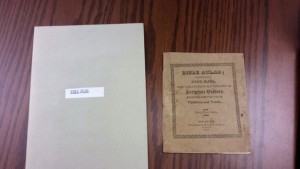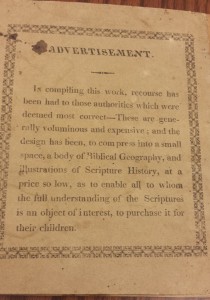At the turn of the nineteenth century, Victorian-era children relied on chapbooks (small paper-covered books or pamphlets) for most of their reading and learning needs. With its 1819 publication, the Bible Atlas marks one of the first periods in times where chapbooks were being produced specifically with younger readers in mind, rather than adults: “By the nineteenth century, the hey-day of chapbook publication for adults was largely over.” (Lamb)

The Bible Atlas and its storage envelope at the RBSC
The cheapness of chapbooks made them accessible to a broader range of readers. The front of the Bible Atlas lists the cost as “PRICE, 37 1-2 cents”. According to measuringworth.com, the modern equivalent of 18 plus 1/2 cents (rounded up to $0.19) is $3.56 in today’s economy. Given that a modern reader would be hard pressed to find any variety of book for under $4 (the modern equivalent would be something like comic books), it’s safe to say that this book was financially accessible.
The teaching aspects of the Bible Atlas are fairly straightforward: the connection of the map with the explanation serves as a tool to understanding the scripture alongside the geographical illustration. However, the practicality of the Bible Atlas being for children is based more in its chapbook form than anything else. The back cover advertisement for the Bible Atlas highlights the accuracy of the work, as well as the accessibility of it:

Back cover Advertisement for the Bible Atlas
“ADVERTISEMENT. In compiling this work, recourse has been had to those authorities which were deemed most correct – These are generally voluminous and expensive; and the design has been, to compress into a small space the, a body of Biblical Geography, and illustrations of Scripture History, at a price so low, as to enable all to whom the full understanding of the Scriptures is an object of interest, to purchase it for their children.”
This Ad demonstrates that a major draw for the Bible Atlas was its low price point; while the content itself does not seem obvious in its usage for children (other than perhaps a sense of simplicity in the wording of the explanations), the marketing of the work as physically accessible is what makes it the most accessible from an education standpoint.
Lam, Siobhan. “Chapbooks in the English Youth and Imagination.” Victorian Web. August 14, 2007.